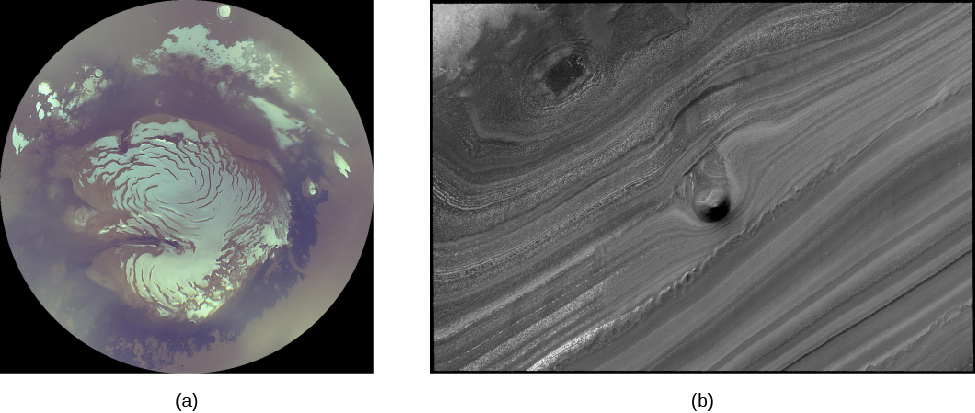| << Chapter < Page | Chapter >> Page > |
Several types of clouds can form in the martian atmosphere. First there are dust clouds, discussed above. Second are water-ice clouds similar to those on Earth. These often form around mountains, just as happens on our planet. Finally, the CO 2 of the atmosphere can itself condense at high altitudes to form hazes of dry ice crystals. The CO 2 clouds have no counterpart on Earth, since on our planet temperatures never drop low enough (down to about 150 K or about 125 °C) for this gas to condense.
Through a telescope, the most prominent surface features on Mars are the bright polar caps, which change with the seasons, similar to the seasonal snow cover on Earth. We do not usually think of the winter snow in northern latitudes as a part of our polar caps, but seen from space, the thin winter snow merges with Earth’s thick, permanent ice caps to create an impression much like that seen on Mars ( [link] ).

The seasonal caps on Mars are composed not of ordinary snow but of frozen CO 2 (dry ice). These deposits condense directly from the atmosphere when the surface temperature drops below about 150 K. The caps develop during the cold martian winters and extend down to about 50° latitude by the start of spring.
Quite distinct from these thin seasonal caps of CO 2 are the permanent or residual caps that are always present near the poles. The southern permanent cap has a diameter of 350 kilometers and is composed of frozen CO 2 deposits together with a great deal of water ice. Throughout the southern summer, it remains at the freezing point of CO 2 , 150 K, and this cold reservoir is thick enough to survive the summer heat intact.
The northern permanent cap is different. It is much larger, never shrinking to a diameter less than 1000 kilometers, and is composed of water ice. Summer temperatures in the north are too high for the frozen CO 2 to be retained. Measurements from the Mars Global Surveyor have established the exact elevations in the north polar region of Mars, showing that it is a large basin about the size of our own Arctic Ocean basin. The ice cap itself is about 3 kilometers thick, with a total volume of about 10 million km 3 (similar to that of Earth’s Mediterranean Sea). If Mars ever had extensive liquid water, this north polar basin would have contained a shallow sea. There is some indication of ancient shorelines visible, but better images will be required to verify this suggestion.

Notification Switch
Would you like to follow the 'Astronomy' conversation and receive update notifications?